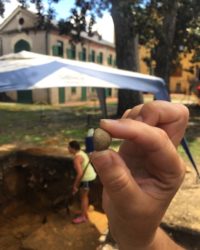A team of archaeologists and college students have unearthed a single lead musket ball from the Revolutionary War in Charleston, South Carolina. This is the first archaeological evidence found of the British lines from the Siege of Charleston in 1780.
Archaeologists and students from the College of Charleston had been excavating behind the historic Aiken-Rhett House (built in 1835 on an infilled work yard) for two weeks in the hopes of discovering physical traces of a British trench that was part of a network of trenches used to besiege the city. A ground-penetrating radar survey indicated significant soil disturbance under the surface, so the team of more than a dozen people was assembled to excavate quickly and efficiently.
 On Wednesday of last week the team was excited to find a lead ball, but their hopes were dashed when it was identified a post-Revolutionary lead shot from a hunting gun. Thursday their luck turned when they dug up a small lead ball that was the proper age, fired by the proper weapon (a musket) and was flattened on one side from the impact against a target. It’s the proverbial smoking gun.
On Wednesday of last week the team was excited to find a lead ball, but their hopes were dashed when it was identified a post-Revolutionary lead shot from a hunting gun. Thursday their luck turned when they dug up a small lead ball that was the proper age, fired by the proper weapon (a musket) and was flattened on one side from the impact against a target. It’s the proverbial smoking gun.
Charleston Museum Director Carl Borick has been searching for the 1780 siege line for nearly 15 years. “Based on these artifacts, my research and the archaeologists’ assessment of the mottled soil in the trench, we have pretty much confirmed it was part of the British siege lines during the 1780 siege.”
As the students worked, the director of museums for the Historic Charleston Foundation, Lauren Northup, led tours around the site explaining in detail what they hoped to discover.
“We have worked for three weeks to uncover evidence of a suspected revolutionary war seize trench dug by the British in 1780,” Northup told Fox News. “We are nearing the end of the field school and we have finally reached the trench.”
Northup says the British-built trenches were open only for a short period of time. “A trench was built very quickly and it was really meant to transport troops safely behind earthworks,” she explained. “Basically once they dug it and passed through they then filled it back in.”
That’s why it has been so difficult to find archaeological evidence of the trenches. They were dug and refilled so quickly, there’s no real structure to find. (They can’t all be Thaddeus Kosciuszko tunnels.) The only indication of their presence is the random stuff that the British troops dropped in the trench, or, as in this case, the remnants of battle.
This one tiny bullet could well crack the whole siege trench network wide open. Researchers will be able to compare the one known trench with military and historic maps of the British siege positions and marked trenches. That will give them an approximate idea of where to find whatever physical evidence survives of the other trenches.